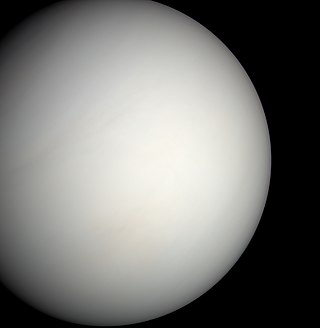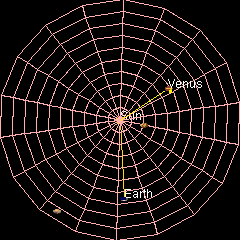
The astronomical unit is a unit of length, roughly the distance from Earth to the Sun and approximately equal to 150 million kilometres or 8.3 light-minutes. The actual distance from Earth to the Sun varies by about 3% as Earth orbits the Sun, from a maximum (aphelion) to a minimum (perihelion) and back again once each year. The astronomical unit was originally conceived as the average of Earth's aphelion and perihelion; however, since 2012 it has been defined as exactly 149597870700 m.

Venus is the second planet from the Sun. It is a rocky planet with the densest atmosphere of all the rocky bodies in the Solar System, and the only one with a mass and size that is close to that of its orbital neighbour Earth. Orbiting inferiorly, it appears in Earth's sky always close to the Sun, as either a "morning star" or an "evening star". While this is also true for Mercury, Venus appears much more prominently, since it is the third brightest object in Earth's sky after the Moon and the Sun, appearing brighter than any other star-like classical planet or any fixed star. With such prominence in Earth's sky, Venus has historically been a common and important object for humans, in both their cultures and astronomy.

In astronomy, a transit is the passage of a celestial body directly between a larger body and the observer. As viewed from a particular vantage point, the transiting body appears to move across the face of the larger body, covering a small portion of it.
Maureen Hunter is a Canadian playwright who lives on the Salish Sea at Sechelt, BC. Hunter was born in Indian Head, Saskatchewan and graduated from the University of Saskatchewan. Throughout her professional career, she lived in Winnipeg, Manitoba. Most of her plays were premiered by the Royal Manitoba Theatre Company. They have been performed in theatres across Canada, as well as in the U.S. and Britain. Transit of Venus was performed by the Royal Shakespeare Company and recorded by the BBC. An opera version of Transit of Venus premiered at Manitoba Opera in 2007. Her plays have been published by Scirocco Drama and Nuage Editions and are available through good bookstores and on Amazon. She is a member of the Playwrights Guild of Canada.

A transit of Venus across the Sun takes place when the planet Venus passes directly between the Sun and a superior planet, becoming visible against the solar disk. During a transit, Venus can be seen from Earth as a small black dot moving across the face of the Sun. The duration of such transits is usually several hours. A transit is similar to a solar eclipse by the Moon. While the diameter of Venus is more than three times that of the Moon, Venus appears smaller, and travels more slowly across the face of the Sun, because it is much farther away from Earth.

A transit of Mercury across the Sun takes place when the planet Mercury passes directly between the Sun and a superior planet. During a transit, Mercury appears as a tiny black dot moving across the Sun as the planet obscures a small portion of the solar disk. Because of orbital alignments, transits viewed from Earth occur in May or November. The last four such transits occurred on May 7, 2003; November 8, 2006; May 9, 2016; and November 11, 2019. The next will occur on November 13, 2032. A typical transit lasts several hours. Mercury transits are much more frequent than transits of Venus, with about 13 or 14 per century, primarily because Mercury is closer to the Sun and orbits it more rapidly.
Guillaume Joseph Hyacinthe Jean-Baptiste Le Gentil de la Galaisière was a French astronomer who discovered several nebulae and was appointed to the Royal Academy of Sciences. He made unsuccessful attempts to observe the 1761 and 1769 transits of Venus from India.
Transit of Venus is a play by Canadian playwright Maureen Hunter. It was first produced at the Manitoba Theatre Centre in November 1992.

The second most recent transit of Venus observed from Earth took place on 8 June 2004. The event received significant attention, since it was the first Venus transit after the invention of broadcast media. No human alive at the time had witnessed a previous Venus transit since that transit occurred on 6 December 1882 in the 19th century.

The 2012 transit of Venus, when the planet Venus appeared as a small, dark spot passing across the face of the Sun, began at 22:09 UTC on 5 June 2012, and finished at 04:49 UTC on 6 June. Depending on the position of the observer, the exact times varied by up to ±7 minutes. Transits of Venus are among the rarest of predictable celestial phenomena and occur in pairs. Consecutive transits per pair are spaced 8 years apart, and consecutive pairs occur more than a century apart: The previous transit of Venus took place on 8 June 2004 ; the next pair of transits will occur on 10–11 December 2117 and December 2125 within the 22nd century.
A Transit of Venus occurs when the planet Venus passes between the Sun and the Earth, as it happened in:

A transit of Mercury across the Sun as seen from Mars takes place when the planet Mercury passes directly between the Sun and Mars, obscuring a small part of the Sun's disc for an observer on Mars. During a transit, Mercury can be seen from Mars as a small black disc moving across the face of the Sun.

Manitoba Opera is an opera company in Winnipeg, Manitoba that was founded in 1969. Its first production was a concert version of Giuseppe Verdi's Il Trovatore in 1972. Manitoba Opera is one of several western Canadian opera companies that flourished under the so-called "father of opera in Western Canada," Irving Guttman. He has been instrumental in the development of many young Canadian singers, including Winnipeg native Tracy Dahl (soprano) and Winkler's Phillip Ens (bass). Both have gone on to international careers.

William Crabtree (1610–1644) was an astronomer, mathematician, and merchant from Broughton, then in the Hundred of Salford, Lancashire, England. He was one of only two people to observe and record the first predicted transit of Venus in 1639.
Victor Albert Davies is a Canadian composer, pianist, and conductor, best known for his opera Transit of Venus and The Mennonite Piano Concerto.

Jeremiah Horrocks, sometimes given as Jeremiah Horrox, was an English astronomer. He was the first person to demonstrate that the Moon moved around the Earth in an elliptical orbit; and he was the only person to predict the transit of Venus of 1639, an event which he and his friend William Crabtree were the only two people to observe and record. Most remarkably, Horrocks correctly asserted that Jupiter was accelerating in its orbit while Saturn was slowing and interpreted this as due to mutual gravitational interaction, thereby demonstrating that gravity's actions were not limited to the Earth, Sun, and Moon.

On 3 June 1769, navigator Captain James Cook, naturalist Joseph Banks, astronomer Charles Green and naturalist Daniel Solander recorded the transit of Venus from the island of Tahiti during Cook's first voyage around the world. During a transit, Venus appears as a small black disc travelling across the Sun. Transits of Venus occur in a pattern that repeats itself every 243 years, with two transits that are eight years apart, separated by breaks of 121.5 and 105.5 years. These men, along with a crew of scientists, were commissioned by the Royal Society of London for the primary purpose of viewing the transit of Venus. Not only would their findings help expand scientific knowledge, it would help with navigation by accurately calculating the observer's longitude. At this time, longitude was difficult to determine and not always precise. A "secret" mission that followed the transit included the exploration of the South Pacific to find the legendary Terra Australis Incognita or "unknown land of the South."

The first known observations and recording of a transit of Venus were made in 1639 by the English astronomers Jeremiah Horrocks and his friend and correspondent William Crabtree. The pair made their observations independently on 4 December that year ; Horrocks from Carr House, then in the village of Much Hoole, Lancashire, and Crabtree from his home in Broughton, near Manchester.

The 1874 Transit of Venus Expedition to Campbell Island was an astronomical expedition by French scientists to observe the 9 December 1874 transit of Venus on subantarctic Campbell Island in the Southern Ocean some 600 km south of New Zealand. It was one of several such scientific expeditions from various countries sent around the world to observe the rare astronomical event.

Venus has an orbit with a semi-major axis of 0.723 au, and an eccentricity of 0.007. The low eccentricity and comparatively small size of its orbit give Venus the least range in distance between perihelion and aphelion of the planets: 1.46 million km. The planet orbits the Sun once every 225 days and travels 4.54 au in doing so, giving an average orbital speed of 35 km/s (78,000 mph).














